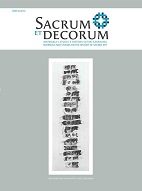„Krużlowa” i „Głowa Chrystusa” Aliny Szapocznikow
“Krużlowa” and “The Head of Christ” by Alina Szapocznikow
Author(s): Agata JakubowskaSubject(s): Cultural history
Published by: Wydawnictwo Uniwersytetu Rzeszowskiego
Keywords: Alina Szapocznikow; Krużlowa; The Head of Christ; Herbarium; Józef Sadzik; Pallottines; The Madonna of Krużlowa; The Stations of the Cross; motherhood; the cast of the body
Summary/Abstract: In 1962 Father JózefSadzik, who was in charge of Éditions du Dialogue arrived at the Pallottine centre in Paris. He established there an important intellectual and spiritual centre which grouped numerous representatives of the Polish émigré community in Paris. Among them was AlinaSzapocznikow, who remained in close touch with Father Sadzik. An expression of their friendship was the sculpture entitled Krużlowa, which Szapocznikow offered to Sadzik in 1969. It is a highly original interpretation of the Madonna of Krużlowa(ca. 1400) or in a broader sense – the iconographic type it represents, i.e. a Beautiful Madonna. Szapocznikow’s art is often described as being centred around the human body: the body suffering during the war, the sick body, the body yearning for love and being desired. Krużlowadraws our attention to one more aspect of corporality – the body which was unable to bear and nourish a child. The Christian image of a Beautiful Madonna proved for Szapocznikow to be a good medium for telling people about this experience. Father Sadzik asked Szapocznikow to cooperate with him on the project of the Centre for Dialogue, which was launched in the early 1970s. For a hall designed especially for the Centre, the artist created TheHead of Christ. It is classified as part of the series called Herbarium, for which the artist used casts of the body of her adopted son, Piotr. It seems plausible that the whole series, which seems to be more tightly connected with the Shroud of Turin than a collection of dried plants, had originally been intended as the consecutive Stations of the Cross.This sculpture is commonly believed to refer directly to the suffering of the artist in the period of time prior to its creation, but above all to cancer that the artist was terminally afflicted with during its creation.The exceptional feature of TheHead of Christ is that the Crucified is in fact her young, healthy son. This piece seems to be the continuation of the story about Mother and Her Son, or a mother / Szapocznikow and her son / Piotr introduced by Krużlowa.In the case of Krużlowathe emphasis is on her internal drama, the (in)ability to be a mother, as if irrespective of the child.In the case of TheHead of Christ her feelings for the son constitute the focus of the story. Both extremely interesting realisations confirm the importance for the artist of the previously underestimated environment of the Pallottines, especially of Father Sadzik.
Journal: Sacrum et Decorum. Materiały i studia z historii sztuki sakralnej
- Issue Year: 2013
- Issue No: 6
- Page Range: 119-131
- Page Count: 13

